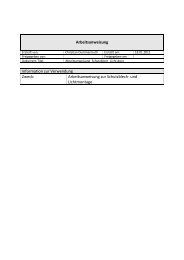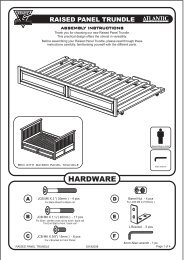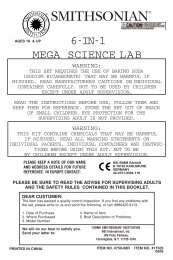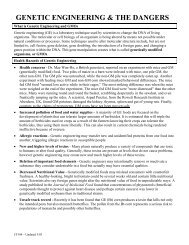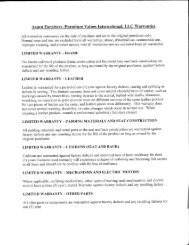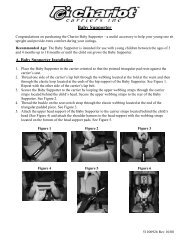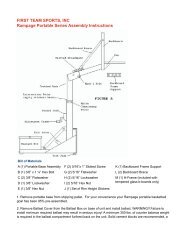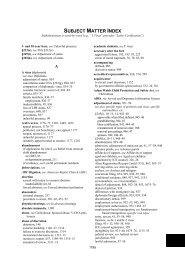Digital Physical Therapy Muscle Stim MPO 5500
Digital Physical Therapy Muscle Stim MPO 5500
Digital Physical Therapy Muscle Stim MPO 5500
You also want an ePaper? Increase the reach of your titles
YUMPU automatically turns print PDFs into web optimized ePapers that Google loves.
INSTRUCTION MANUAL<br />
FOR THE<br />
<strong>MPO</strong> <strong>5500</strong><br />
<strong>Digital</strong> <strong>Physical</strong> <strong>Therapy</strong> <strong>Muscle</strong> <strong>Stim</strong><br />
Distributed by:<br />
FDA 510K<br />
V1.0
INDEX<br />
Chapter Contents Page<br />
1. Introduction .......................................................... 2<br />
2. Cautions ................................................................ 3<br />
3. Warnings ............................................................... 4<br />
4. Contraindications ................................................ 4<br />
5. Adverse Reactions .............................................. 4<br />
6. General Description ............................................. 5<br />
7. Construction ......................................................... 6<br />
8. Technical Specifications ...................................... 8<br />
9. Replacement Parts .............................................. 10<br />
10. Accessories ......................................................... 10<br />
11. Graphic Symbols .................................................. 11<br />
12. Operating Instructions ........................................ 12<br />
13. Attachment of Electrode Lead Wires ................. 12<br />
14. Lead Wire Maintenance ....................................... 13<br />
15. Electrode Options ................................................ 13<br />
16. Electrode Placement ........................................... 13<br />
17. Tips for Skin Care ................................................ 14<br />
18. Application of Reusable self adhesive<br />
electrodes ............................................................ 15<br />
19. Adjusting the Controls ........................................ 16<br />
20. Battery Information .............................................. 22<br />
21. Maintenance, Transportation, and Storage of<br />
TENS Device.......................................................... 24<br />
22. Safety-Technical Controls ................................... 24<br />
23. Malfunctions ......................................................... 25<br />
24. Conformity to Safety Standards ......................... 25<br />
25. Warranty ................................................................ 25<br />
1
EXPLANATION OF EMS<br />
Chapter 1 : INTRODUCTION<br />
Electrical <strong>Muscle</strong> <strong>Stim</strong>ulation is an internationally accepted and<br />
proven way of treating muscular injuries. It works by sending<br />
electronic pulses to the muscle needing treatment; this causes the<br />
muscle to exercise passively.<br />
It is a product derived from the square waveform, originally invented<br />
by John Faraday in 1831. Through the square wave pattern it is<br />
able to work directly on muscle motor neurons. The <strong>MPO</strong> <strong>5500</strong><br />
<strong>Digital</strong> <strong>Physical</strong> <strong>Therapy</strong> <strong>Muscle</strong> <strong>Stim</strong> has low frequency and this in<br />
conjunction with the square wave pattern allows direct work on<br />
muscle groupings. This is being widely used in hospitals and sports<br />
clinics for the treatment of muscular injuries and for the re-education<br />
of paralyzed muscles, to prevent atrophy in affected muscles and<br />
improving muscle tone and blood circulation.<br />
HOW EMS WORKS<br />
1. Relaxation of muscle spasms<br />
2. Prevention or retardation of disuse atrophy<br />
3. Increasing local blood circulation<br />
4. <strong>Muscle</strong> re-education<br />
5. Immediate post-surgical stimulation of calf muscles to prevent<br />
venous thrombosis<br />
6. Maintaining or increasing range of motion<br />
The EMS units send comfortable impulses through the skin that<br />
stimulate the nerves in the treatment area. When the muscle<br />
receives this signal it contracts as if the brain has sent the signal<br />
itself. As the signal strength increases, the muscle flexes as in<br />
physical exercise. Then when the pulse ceases, the muscle relaxes<br />
and the cycle starts over again, (<strong>Stim</strong>ulation, Contraction and<br />
Relaxation.) Powered muscle stimulators should only be used under<br />
medical supervision for adjunctive therapy for the treatment of<br />
medical diseases and conditions.<br />
2<br />
I<strong>MPO</strong>RTANT SAFETY INFORMATION!<br />
Read instruction manual before operation. Be sure to comply with<br />
all “CAUTIONS” and “WARNINGS” in the manual. Failure to follow<br />
instructions can cause harm to user or device.<br />
Chapter 2: CAUTIONS<br />
1. Federal law (USA) restricts this device to sale by or on the<br />
order of a physician<br />
2. Safety of powered muscle stimulators for use during pregnancy<br />
has not been established.<br />
3. Caution should be used for patients with suspected or diagnosed<br />
heart problems.<br />
4. Caution should be used for patients with suspected or diagnosed<br />
epilepsy.<br />
5. Caution should be used in the presence of the following:<br />
a. When there is a tendency to hemorrhage following acute<br />
trauma or fracture;<br />
b. Following recent surgical procedures when muscle<br />
contraction may disrupt the healing process;<br />
c. Over the menstruating or pregnant uterus; and<br />
d. Over areas of the skin which lack normal sensation.<br />
6. Some patients may experience skin irritation or hypersensitivity<br />
due to the electrical stimulation or electrical conductive medium.<br />
The irritation can usually be reduced by using an alternate<br />
conductive medium, or alternate electrode placement.<br />
7. Electrode placement and stimulation settings should be based<br />
on the guidance of the prescribing practitioner.<br />
8. Powered muscle stimulators should be kept out of the reach of<br />
children.<br />
9. Powered muscle stimulators should be used only with the leads<br />
and electrodes recommended for use by the manufacturer.<br />
10 Portable powered muscle stimulators should not be used while<br />
driving, operating machinery, or during any activity in which<br />
involuntary muscle contractions may put the user at undue<br />
risk of injury.<br />
3
Chapter 3 : WARNINGS<br />
1. The long-term effects of chronic electrical stimulation are<br />
unknown.<br />
2. <strong>Stim</strong>ulation should not be applied over the carotid sinus nerves,<br />
particularly in patients with a known sensitivity to the carotid<br />
sinus reflex.<br />
3. <strong>Stim</strong>ulation should not be applied over the neck or mouth. Severe<br />
spasm of the laryngeal and pharyngeal muscles may occur and<br />
the contractions may be strong enough to close the airway or<br />
cause difficulty in breathing.<br />
4. <strong>Stim</strong>ulation should not be applied transthoracically in that the<br />
introduction of electrical current into the heart may cause cardiac<br />
arrhythmias.<br />
5. <strong>Stim</strong>ulation should not be applied transcerebrally.<br />
6. <strong>Stim</strong>ulation should not be applied over swollen, infected, or<br />
inflamed areas or skin eruptions, e.g., phlebitis, thrombophlebitis,<br />
varicose veins, etc.<br />
7. <strong>Stim</strong>ulation should not be applied over, or in proximity to,<br />
cancerous lesions.<br />
Chapter 6: GENERAL DESCRIPTION<br />
The <strong>MPO</strong> <strong>5500</strong> <strong>Digital</strong> <strong>Physical</strong> <strong>Therapy</strong> <strong>Muscle</strong> <strong>Stim</strong> is a battery<br />
operated pulse generator that sends electrical impulses through<br />
electrodes to the body and reaches the underlying nerves or muscle<br />
group. The device is provided with two controllable output channels,<br />
each independent of each other. An electrode pair can be connected<br />
to each output channel.<br />
The electronics of the <strong>MPO</strong> <strong>5500</strong> <strong>Digital</strong> <strong>Physical</strong> <strong>Therapy</strong> <strong>Muscle</strong><br />
<strong>Stim</strong> create electrical impulses whose Intensity, Pulse Width, Pulse<br />
Rate, Contraction, Relaxation and Ramp may be altered with the<br />
switches. Press buttons are very easy to use and the panel cover<br />
prevents accidental changes in the setting.<br />
.<br />
Chapter 4: CONTRAINDICATION<br />
Powered muscle stimulators should not be used on patients with<br />
cardiac demand pacemakers.<br />
Chapter 5: ADVERSE REACTIONS<br />
Skin irritation and burns beneath the electrodes have been reported<br />
with the use of powered muscle stimulators. If skin irritation occurs,<br />
discontinue use and consult your physician.<br />
4<br />
5
Chapter 7 : CONSTRUCTION<br />
LCD<br />
(1) MODE<br />
(2) TIMER<br />
(3) PULSE WIDTH / RATE<br />
(4) RAMP / ON / OFF TIMER<br />
(5) OUTPUT INDICATOR<br />
FRONT<br />
(1) LEAD CONNECTOR<br />
(2) INTENSITY CONTROL ( ON/OFF SWITCH)<br />
(3) LIQUID CRYSTAL DISPLAY<br />
(4) MODE CONTROL<br />
(5) SET CONTROL<br />
(6) INCREMENT CONTROL<br />
(7) DECREMENT CONTROL<br />
(8) TIMER CONTROL<br />
(9) BATTERY STRIP<br />
(10) BATTERY COMPARTMENT<br />
(11) BELT CLIP<br />
(12) PROTECTIVE COVER<br />
6<br />
7
Chapter 8 : TECHNICAL SPECIFICATIONS<br />
The technical specification details of <strong>MPO</strong> <strong>5500</strong> <strong>Digital</strong> <strong>Physical</strong> <strong>Therapy</strong><br />
<strong>Muscle</strong> <strong>Stim</strong> are as follows:<br />
MECHANISM TECHNICAL DESCRIPTION<br />
01 Channel Dual, isolated between channels<br />
02 Pulse Amplitude Adjustable 0-100 mA into 500 ohm load<br />
each channel.<br />
03 Output Voltage Adjustable 0-50V, Max output 50V peak to<br />
peak into 500ohm load each channel.<br />
04 Wave Form Asymmetrical rectangular biphasic pulse.<br />
05 Power Supply One 9 Volt Battery, type 6F22<br />
06 Size 10.1cm(L) x 6.4cm(W) x 2.5cm(H)<br />
07 Weight 140 grams (battery included)<br />
08 On Time Adjustable, 2~90 seconds , 1 Sec./ step<br />
09 Off Time Adjustable, 0~90 seconds , 1 Sec./ step<br />
10 Ramp Time Adjustable, 1~8 seconds, 1 Sec./ step, The<br />
“On” time will increase and decrease in<br />
the setting value.<br />
11 Pulse Rate Adjustable, 2~150 Hz , 1Hz / step<br />
12 Pulse Width Adjustable, 50~300µs ,10µs / step<br />
13 Timer Adjustable, 15, 30, 45, 60 minutes or<br />
Continue.<br />
14 Output Mode Constant ,Synchronous, Alternate<br />
15 Constant(C) Constant stimulation based on setting<br />
value. Only pulse width, pulse rate and<br />
timer are adjustable in this mode.<br />
“Constant” is equal to the “Normal” mode<br />
of a TENS unit.<br />
16 Synchronous(S) <strong>Stim</strong>ulation of both channels occurs<br />
synchronously. The “ON” time including<br />
“Ramp Up” and “Ramp Down” time.<br />
Therefore, the setting of ON Time should<br />
be no less than two times of the “Ramp”<br />
time in this mode.<br />
8<br />
ON TIME ≥ Ramp up + Ramp down<br />
17 Alternate(A) The stimulation of the CH2 will occur after<br />
the 1st contraction of CH1 is completed. In<br />
this mode, the setting of ON Time should<br />
be no less than two times of the “Ramp”<br />
time. The OFF Time should be equal or more<br />
than the ON Time.<br />
ON TIME ≥Ramp up + Ramp down<br />
OFF TIME ≥ON TIME<br />
18 Compliance Meter The accumulated treatment time can be<br />
recorded. Total recorded time is 999 hours.<br />
19 Operating Temperature:0°~40°C<br />
Condition Relative Humidty:30%~75%<br />
Atmosphere Pressure : 700Hpa~1060Hpa<br />
20 Tolerance There may be a +/-10% tolerance of all<br />
settings and +/- 20% tolerance of output<br />
of intensity.<br />
9
Chapter 9 : REPLACABLE PARTS<br />
The replaceable parts and accessories of EV-804A DIGITAL TENS<br />
devices are as given below –Except leads, electrodes, battery and<br />
battery case cover, please do not try to replace the other parts of<br />
a device.<br />
PARTS<br />
01 ELECTRODES LEADS<br />
02 ELECTRODES<br />
03 9V BATTERY ,TYPE 6F22<br />
04 BELT CLIP<br />
05 BATTERY CASE COVER<br />
06 LEADCONNECTOR<br />
07 MAIN PCB<br />
08 INTENSITY KNOB<br />
09 LCD COVER<br />
10 INTENSITY CONTROLCOVER<br />
Chapter 10 : ACCESSORIES<br />
Each EV-804A DIGITAL TENS comes complete with standard<br />
accessories and the standard labels as given below:<br />
I. Accessories<br />
REF. NO. DESCRIPTION Q’TY<br />
1. TKS5050 50 X 50 mm Adhesive Electrodes 4 pieces<br />
2. KE-26 Electrodes Leads 2 pieces<br />
3. 9 V Battery, type 6F22 1piece<br />
4. Instruction Manual 1 piece<br />
5. Carrying Case 1 piece<br />
II. LABEL<br />
The label attached to the back of<br />
device contains important<br />
information about this device- model,<br />
supply voltage, CE number and<br />
caution. Please do not remove.<br />
Chapter 11 : GRAPHIC SYMBOLS<br />
1. Note Operating Instructions<br />
2. Degree of Electrical Protection BF<br />
3. Do not insert the plug into AC power supply socket.<br />
4. Timer<br />
5. Consult Operation Instructions<br />
6. Manufacturer<br />
7. Serial Number<br />
8. DC Current(DC Power source)<br />
9. Increment<br />
10. Decrement<br />
10<br />
11
Chapter 12: OPERATING INSTRUCTIONS<br />
1) Insert the 9V battery into the device ’s battery compartment.<br />
Make sure to remove the plastic seal on the 9V battery. Line up<br />
the positive and negative terminals on the battery with their<br />
corresponding terminals in the device. Make sure that both<br />
Intensity control (ON/OFF Switch) knobs are in the off position.<br />
2) Insert the lead wires into the lead wire sockets on top of the<br />
device.<br />
3) Open the electrode package. Then insert each lead wire pin<br />
into the pig tail of the electrodes<br />
4) Place the electrode on your body as directed by your physician.<br />
5) Slowly turn on the device by rotating the Intensity control<br />
(ON /OFF Switch) knobs.<br />
6) Select the mode and settings as directed by your physician.<br />
7) Slowly increase or decrease the intensity as directed by your<br />
physician by rotating the Intensity control (ON/OFF Switch)<br />
clockwise to increase, counter clockwise to decrease.<br />
8) After Treatment, Turn the device off by rotating the Intensity<br />
control (ON/OFF Switch) counter clockwise to the zero setting.<br />
Chapter 13 : ATTACHMENT OF ELECTRODE<br />
LEAD WIRES<br />
The wires provided with the system insert into the jack sockets<br />
located on top of the device. Holding the insulated portion of the<br />
connector, push the plug end of the wire into one of the jacks (see<br />
drawing); one or two sets of wires may be used.<br />
12<br />
After connecting the wires to the stimulator, attach each wire to<br />
an electrode. Use care when you plug and unplug the wires.<br />
Jerking the wire instead of holding the insulated connector body<br />
may cause wire breakage.<br />
CAUTION<br />
Do not insert the plug of the patient lead wire into any AC power<br />
supply socket.<br />
Chapter 14: LEAD WIRE MAINTENANCE<br />
Clean the wires by wiping with a damp cloth. Coating them lightly<br />
with talcum powder will reduce tangling and prolong life.<br />
Chapter 15 : ELECTRODE OPTIONS<br />
The electrodes are disposable and should be routinely replaced<br />
after 3-4 uses. If you are unsure of your electrode adhesive<br />
properties, order replacement electrodes. Replacement electrodes<br />
should be re-ordered through Medical Products Online, Inc (877-<br />
760-7246) to ensure proper quality. Follow application procedures<br />
outlined in electrode packing, to maintain optimal stimulation and to<br />
prevent skin irritation.<br />
Chapter 16: ELECTRODE PLACEMENT<br />
The placement of electrodes can be one of the most important<br />
parameters in achieving success with EMS therapy. Of utmost<br />
importance is the willingness of the physician to try the various<br />
styles of electrode placement to find which method best fits the<br />
needs of the individual patient.<br />
Every patient responds to electrical stimulation differently and their<br />
needs may vary from the conventional settings suggested here. If<br />
13
the initial results are not positive, speak to your physician about<br />
alternative stimulation settings and/or electrode placements. Once<br />
an acceptable placement has been achieved, mark down the<br />
electrodes sites and the settings, so the patient can easily continue<br />
treatment at home.<br />
Chapter 17: TIPS FOR SKIN CARE<br />
To avoid skin irritation, especially if you have sensitive skin, follow<br />
these suggestions:<br />
1. Wash the area of skin where you will be placing the electrodes,<br />
using mild soap and water before applying electrodes, and after<br />
taking them off. Be sure to rinse soap off thoroughly and dry skin well.<br />
2. Excess hair may be clipped with scissors; do not shave stimulation area.<br />
3. Wipe the area with the skin preparation your physician has<br />
recommended. Let this dry. Apply electrodes as directed.<br />
4. Many skin problems arise from the “pulling stress” from adhesive<br />
patches that are excessively stretched across the skin during<br />
application. To prevent this, apply electrodes from centre<br />
outward; avoid stretching over the skin.<br />
Chapter 18: APPLICATION OF RE-USABLE SELF<br />
Application<br />
ADHESIVEELECTRODES<br />
1. Clean and dry the skin at the prescribed area thoroughly with<br />
soap and water prior to application of electrodes.<br />
2. Insert the lead wire into the pin connector on the pre-wired<br />
electrodes.<br />
3. Remove the electrodes from the protective liner and apply the<br />
electrodes firmly to the treatment site.<br />
Removal<br />
1. Lift at the edge of electrodes and peel; do not pull on the lead<br />
wires because it may damage the electrodes.<br />
2. Place the electrodes on the liner and remove the lead wire by<br />
twisting and pulling at the same time.<br />
5. To minimize “pulling stress”, tape extra lengths of lead wires to<br />
the skin in a loop to prevent tugging on electrodes.<br />
6. When removing electrodes, always remove by pulling in the<br />
irection of hair growth.<br />
7. It may be helpful to rub skin lotion on electrode placement area<br />
when not wearing electrodes.<br />
8. Never apply electrodes over irritated or broken skin .<br />
Care and Storage<br />
1. Between uses, store the electrodes in the resealed bag in a<br />
cool dry place.<br />
2. It may be helpful to improve repeated application by spreading a<br />
few drops of cold water over the adhesive and turn the surface<br />
up to air dry. Over Saturation with water will reduce the adhesive<br />
properties.<br />
14<br />
15
Important<br />
1. Do not apply to broken skin.<br />
2. The electrodes should be discarded and re-ordered from your<br />
physician when they are no longer adhering.<br />
3. The electrodes are intended for single patient use only.<br />
4. If irritation occurs, discontinue use and consult your physician.<br />
5. Read the instructions for use of self-adhesive electrodes before<br />
application.<br />
To reduce the current strength or switch the device off, turn the<br />
control counter clockwise to the required setting or off-position,<br />
respectively.<br />
The controls are protected by a cap to avoid unintentional change<br />
of intensity.<br />
Chapter 19 : ADJUSTING THE CONTROLS<br />
1. Slide-on Cover:<br />
A slide-on panel cover covers the controls for selecting mode<br />
and adjusting settings. Your medical professional may wish to<br />
set these controls for you and request that you leave the cover<br />
in place.<br />
3. Lead Connector<br />
Connection of the electrodes is made with the two-lead connector<br />
(lead wires). The device must be switched off before connecting<br />
the cables. Both intensity controls must be at the Off position.<br />
Electrodes must be pressed firmly on the skin.<br />
2. Power On/Off Switch and Intensity Controls:<br />
If both controls are in the off-position, the device is switched off.<br />
By turning the controls clockwise, the appropriate channel is<br />
switched on and the indicator of power (CH1 or CH2) will reveal<br />
on the LCD.<br />
The current strength of the impulses transmitted to the electrodes<br />
increases further when the control is turned clockwise.<br />
16<br />
4. Mode Control<br />
There are 3 modes available – Constant, Synchronous and<br />
Alternate. A mode can be selected by pressing the “Mode”<br />
control.<br />
17
5. Set Control<br />
By pressing the “Set” control, you may enter the setting you<br />
intend to make adjustment. You may start to set the value by<br />
pressing the “Increment” and “Decrement” controls when the<br />
value is flashing.<br />
6. Increment Control<br />
This button controls the increase of settings. When pressing<br />
this button, the parameter will increase. Press the button until<br />
the value desired is reached.<br />
7. Decrement Control<br />
This button controls the decrease of parameter. When pressing<br />
this button, the parameter will decrease. Press the button until<br />
the value desired is reached.<br />
9. Steps to Set a New Program<br />
The settings can be adjusted according to the following steps.<br />
a.Turn on the Intensity<br />
After the electrodes are placed firmly on skin and the lead<br />
wires are plugged in the socket of device, turn the on/off<br />
control clockwise. The menu will reveal on LCD. Notice the<br />
indication of power and function on the LCD.<br />
b.Select Mode<br />
Select a mode by pressing the “Mode” control. The mode you<br />
selected will show up on the top of liquid crystal display.<br />
When “ Constant” mode is selected, you can set only pulse<br />
width, pulse rate and timer later on. All parameters are<br />
adjustable on the Synchronous and Alternate mode.<br />
After a mode is selected, press “SET” control to enter next<br />
setting. You may adjust the setting only when the value is<br />
flashing. Then press the “Increment” or “Decrement” control<br />
to change the settings. Repeat the same procedure until all<br />
settings are adjusted. The program will be stored automatically<br />
after created.<br />
8. Timer<br />
The treatment time can be selected by pressing the “Timer”<br />
control. There are five settings available, 15, 30, 45, 60 minutes<br />
and continue. Press the “Timer” control to select a setting<br />
needed. The output of unit will be shut off when time is up.<br />
c. Set Pulse Width<br />
The pulse width determines the length of time. Each electrical<br />
signal is applied through the skin, which controls the strength<br />
and sensation of the stimulation. Press “SET” control to enter<br />
this setting after “Off” time is adjusted. The pulse width is<br />
adjustable from 50 to 300 µs. Press the increment or decrement<br />
controls to adjust the setting.<br />
d. Set Pulse Rate<br />
The pulse rate determines how many electrical impulses are<br />
applied through the skin each second. Press “SET” to enter this<br />
18<br />
19
menu. By pressing the increment and decrement controls, the<br />
number of current impulses per second (Hz) for both channels<br />
can be continually adjusted. The pulse rate is adjustable from 2<br />
Hz to 150 Hz.<br />
In Alternate mode, the OFF Time should be equal or more than<br />
the ON Time. (OFF TIME ≥ ON TIME)<br />
e. Set Ramp Time<br />
The ramp time controls the time of output current that increase<br />
from 0 to the setting level, and from the setting value to 0. When<br />
the ramp time is set, each contraction may be ramped up and<br />
down in order that the signals come on and come off gradually<br />
and smoothly. The ramp time is adjustable from 1 to 8 seconds.<br />
h. Set Timer<br />
The treatment time can be selected by pressing the “Timer”<br />
control. There are five settings available, 15, 30, 45, 60 minutes<br />
and continue. Press the “Timer” control to select a setting<br />
needed. The treatment time will countdown automatically one<br />
minute by one minute. Its output will be shut off when time is up.<br />
f. Set On Time<br />
The On Time controls the time of stimulation. By pressing the<br />
“Set” control, the contraction time can be adjusted. Both<br />
channels’ stimulation is cycled on and off by the contraction<br />
and relaxation settings. The range is adjustable from 2 seconds<br />
to 90 seconds.<br />
As the “ON” time including the ramp up and ramp down time, the<br />
setting of it should be no less than two times of the “Ramp” time.<br />
(ON TIME ≥ Ramp up + Ramp down)<br />
g. Set Off Time<br />
The Off Time controls the time of relaxation. By pressing the<br />
“SET” control, the relaxation time can be adjusted. Both channels’<br />
stimulation is cycled on and off by the contraction and relaxation<br />
settings. The range is adjustable from 0 to 90 seconds.<br />
20<br />
21<br />
Treatment Tim countdown<br />
The treatment time will countdown automatically one minute<br />
by one minute. Its output will be shut off when time is up.<br />
12. Patient Compliance Meter<br />
The accumulated treatment time can be checked and deleted by<br />
the following steps. Total recorded time is 999 hours.<br />
Check & Delete Accumulative Record<br />
Press “Mode” control and turn on the power simultaneously.<br />
The LCD will show the accumulated operation time. Press “Timer”<br />
control and the Record will be deleted followed by a beeper sound.<br />
RESET
10.Check/Replace the Battery:<br />
Over time, in order to ensure the functional safety of TENS,<br />
changing the battery is necessary.<br />
1. Make sure that both intensity controls<br />
are switched to off position.<br />
2. Slide the battery compartment cover<br />
and open.<br />
3. Remove the battery from the<br />
compartment.<br />
4. Insert the battery into the compartment.<br />
Note the polarity indicated on the battery<br />
and in the compartment.<br />
5. Replace the battery compartment cover<br />
and press to close.<br />
PRECATIONS<br />
Chapter 20: BATTERY INFORMATION<br />
1. Remove battery if equipment is not likely to be used for some<br />
time.<br />
2. Please recycle the used battery in accordance with domestic<br />
regulation.<br />
3. Do not throw the used battery into fire.<br />
If you use rechargeable batteries, please follow the instructions.<br />
RECHARGEABLE BATTERIES(NOT INCLUDED)<br />
Prior to the use of a new unit, the rechargeable battery should be<br />
charged according to the battery manufacturer’s instructions.<br />
Before using the battery charger, read all instructions and cautionary<br />
markings on the battery and in this instruction manual.<br />
After being stored for 60 days or more, the batteries may lose their<br />
charge. After long periods of storage, batteries should be charged<br />
prior to use.<br />
22<br />
BATTERY CHARGING<br />
(1) Plug the charger into any working 110 or 220/240v mains<br />
electrical outlet. The use of any attachment not supplied with<br />
the charger may result in the risk of fire, electric shock, or<br />
injury to persons.<br />
(2) Follow the battery manufacturer’s instructions for charging time.<br />
(3) After the battery manufacturer ’s recommended charging time<br />
has been completed, unplug the charger and remove the battery.<br />
(4) Batteries should always be stored in a fully charged state.<br />
To ensure optimum battery performance, follow these<br />
guidelines:<br />
(a) Although overcharging the batteries for up to 24 hours will<br />
not damage them, repeated overcharging may decrease<br />
useful battery life.<br />
(b) Always store batteries in their charged condition. After a<br />
battery has been discharged, recharge it as soon as<br />
possible.If the battery is stored more than 60 days, it may<br />
need to be recharged.<br />
(c)Do not short the terminals of the battery. This will cause the<br />
battery to get hot and can cause permanent damage. Avoid<br />
storing the batteries in your pocket or purse where the<br />
terminals may accidentally come into contact with coins,<br />
keys or any metal objects.<br />
(d)WARNINGS:<br />
1.Do not attempt to charge any other types of batteries in<br />
your charger, other than rechargeable batteries made for<br />
your charger. Other types of batteries may leak or burst.<br />
2.Do not incinerate the rechargeable battery as it may<br />
explode!<br />
23
Chapter 21: MAINTENANCE, TRANSPORTATION<br />
AND STORAGE OF TENS DEVICE<br />
1. Non-flammable cleaning solution is suitable for cleaning the<br />
device.<br />
Note: Do not smoke or work with open lights (for example,<br />
candles,etc.)<br />
when working with flammable liquids.<br />
2. Stains and spots can be removed with a cleaning agent.<br />
3. Do not submerge the device in liquids or expose it to large<br />
amounts of water.<br />
4. Return the device to the carrying box with sponge foam to<br />
ensure that the unit is well-protected before transportation.<br />
5. If the device is not to be used for a long period of time, remove<br />
the batteries from the battery compartment (acid may leak from<br />
used batteries and damage the device). Put the device and<br />
accessories in carrying box and keep it in cool dry place.<br />
6. The packed TENS device should be stored and transported under<br />
the temperature range of -20 °C - + 60°C, relative humidity 20%<br />
- 95%, atmosphere pressure 500 hPa - 1060 hPa.<br />
Chapter 22: SAFETY-TECHNICAL CONTROLS<br />
For safety reasons, check your <strong>MPO</strong> <strong>5500</strong> <strong>Digital</strong> <strong>Physical</strong> <strong>Therapy</strong><br />
<strong>Muscle</strong> <strong>Stim</strong> each week based on the following checklist.<br />
1. Check the device for external damage.<br />
- deformation of the housing.<br />
- damaged or defective output sockets.<br />
2. Check the device for defective operating elements.<br />
- legibility of inscriptions and labels.<br />
- make sure the inscriptions and labels are not distorted.<br />
3. Check LCD<br />
- Parameters must be visible on the CLD.<br />
4. Check the usability of accessories.<br />
- patient cable undamaged.<br />
- electrodes undamaged.<br />
24<br />
Please consult your distributor if there are any problems with device<br />
and accessories.<br />
Chapter 23 : MALFUNCTIONS<br />
Should any malfunctions occur while using the <strong>MPO</strong> <strong>5500</strong> <strong>Digital</strong><br />
<strong>Physical</strong> <strong>Therapy</strong> <strong>Muscle</strong> <strong>Stim</strong>, check<br />
- whether the parameters are set to the appropriate form of<br />
therapy. Adjust the control correctly.<br />
- whether the cable is correctly connected to the device. The<br />
cables should be inserted completely into the sockets.<br />
- whether the LCD reveals the menu. If necessary, insert a new<br />
battery.<br />
- for possible damage to the cable. Change the cable if any damage<br />
is detected.<br />
* If there is any other problem, please return the device to your<br />
distributor. Do not try to repair a defective device.<br />
Chapter 24: CONFORMITY TO SAFETY STANDARDS<br />
The <strong>MPO</strong> <strong>5500</strong> <strong>Digital</strong> <strong>Physical</strong> <strong>Therapy</strong> <strong>Muscle</strong> <strong>Stim</strong> devices are in<br />
compliance with the EN 60601-1-2:2001 and EN 60601-1:1990+A1:<br />
1993+A2:1995+A13:1996 safety standards.<br />
Chapter 25: WARRANTY<br />
All <strong>MPO</strong> <strong>5500</strong> <strong>Digital</strong> <strong>Physical</strong> <strong>Therapy</strong> <strong>Muscle</strong> <strong>Stim</strong> models carry<br />
a warranty of three years from the date of delivery. The warranty<br />
applies to the stimulator only and covers both parts and labour<br />
relating thereto.<br />
The warranty does not apply to damage resulting from failure to<br />
follow the operating instructions, accidents, abuse, alteration or<br />
disassembly by unauthorized personnel.<br />
25




